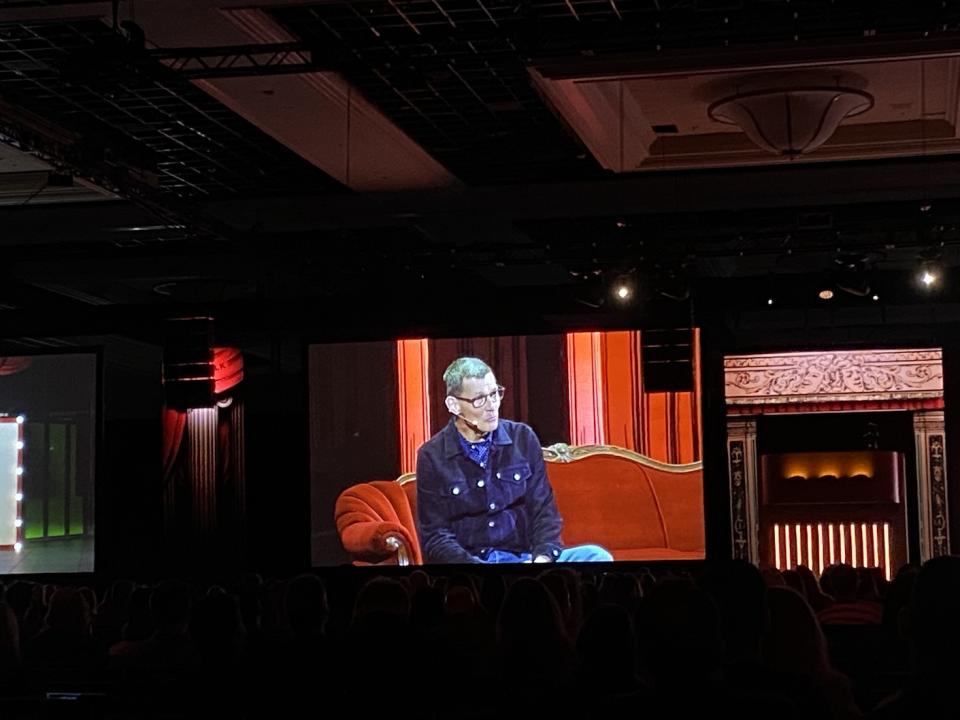Levi’s’ Chip Bergh Calls Succession Plan ‘Biggest Legacy’
- Oops!Something went wrong.Please try again later.

Click here to read the full article.
“The skinny jean is not dead.”
Levi Strauss & Co. CEO Chip Bergh has long held that sentiment as current denim trends shift toward baggier, straight jeans for women. But while Bergh reiterated his adulation for skinny styles in front of a packed audience at the Shoptalk conference in Las Vegas last month, he also acknowledged the wider benefits that the trend shift brings to fashion.
“A new denim cycle is a good thing,” Bergh told CNBC “Squawk on the Street” anchor Sara Eisen at the event. “The skinny jean denim cycle lasted for over a decade, so we’re in the very early innings of the new denim cycle. And it drives the rest of apparel. When the silhouette changes on a pair of jeans, the top changes, the shoes change, everything else changes. It’s good for the apparel industry.”
Not shy about making any more proclamations, Bergh also said, “There is no question that brick-and-mortar is here to stay,” highlighting the denim giant’s store opening pace of 100 locations per year across mixed formats, be it stand-alone or within a mall.
“We’ve really put an emphasis on the main line doors, which sells a better product, which has always been a challenge for us here in the U.S.,” Bergh said, keeping optimism that the stores have a bright future in the market. “Most of our doors in the U.S. historically have been outlet doors. The dirty secret of the apparel business is that’s where a lot of profit is made. But our main line doors now are very, very successful and we keep investing there.”

Bergh’s keynote comes as he is planning to hand the CEO reins over to president and interim chief exec Michelle Gass, who officially jumped ship from Kohl’s over the winter. At the time of the announcement in November, Levi’s said Gass would assume the role within 18 months—but that timeline has not changed or been further narrowed down since.
When prodded again by Eisen on the end of his tenure, Bergh repeated “sometime in the next 18 months,” generating laughs throughout the audience.
The current CEO praised Gass—who like Bergh, is a Procter & Gamble alum—for her humility in handling multiple activist investor campaigns and challenges in the Kohl’s business. Bergh stressed that while he was the type of brand-building exec Levi Straus & Co. needed 12 years ago when he joined the company, Gass was what the denim icon needs in 2023 and beyond.
“We’re doubling down on retail, we’re doubling down on digital and our consumer has changed,” Bergh said. “We are becoming more and more of a real retailer, and Michelle brings almost 30 years of real retail experience with 17 years at Starbucks, and then the last 10 years at Kohl’s.”
Kohl’s had been one of Levi’s biggest customers when the Covid-19 pandemic broke out in 2020, which led to more conversations between Bergh and Gass and a strengthened relationship through 2022 before he reached out to her to succeed him in the CEO role.
“My biggest legacy—it’s not the turnaround. It’s not taking the company public,” Bergh said. “My biggest legacy will be a successful successor who takes the company to the next level.”
Bergh also touched lightly on resale, which has been a major growth area across retail and was a popular topic across the Shoptalk event. With teen children of his own, the CEO said he understood the importance of thrifting to younger generations of consumers, calling secondhand shopping “where the puck is heading.”
“Levi’s vintage is something that people will pay a premium for—they will go hunting for it. Nothing validates the value of our brand more than someone who’s willing to pay $300 or $400 for a vintage trucker jacket, where we sell them brand new for $100, or $150. That really does speak to the power of the brand.”
The artificial intelligence buzzword found its way into the conversation as well, as Bergh talked about Levi’s new partnership with Lalaland.ai, an AI-powered digital fashion studio that creates lifelike fashion models.
“We’re shooting photography for e-commerce sites all over the world on our product assortment, and our circuits vary from the U.S. to Europe to Asia,” said Bergh. “Just shooting the photography for our site is a pretty complex operation, and you have to hire models for it. And that is somewhat limiting in terms of your full potential. The ability to use digital models along with digital imagery of our products is potentially revolutionary. It can drive incredible efficiency, lower the cost and give us a much wider range of potential models.”
The AI models have generated backlash from some consumers after the launch, particularly due to criticisms that Levi’s should instead be hiring more diverse models for photo shoots. In the wake of the outcry, the denim brand put out a statement saying that it was not scaling back plans for live photo shoots, the use of live models or its own commitment to working with diverse models.
The presentation came a week before Levi Strauss & Co. posted its first-quarter earnings, with the brand reporting net revenues of $1.69 billion, an increase of 6 percent from the prior-year quarter and a 9 percent jump on a constant-currency basis. But net income fell 41 percent to $114.7 million and inventory remained 33 percent higher than the year-ago period.
For the full year, Levi still expects full-year adjusted EPS of $1.30 to $1.40 and revenue of $6.3 billion to $6.4 billion, which would reflect reported revenue growth of 1.5 percent to 3 percent year-over-year.

